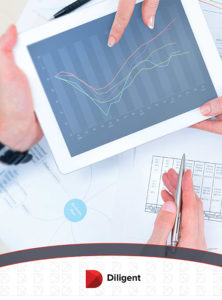Environment, social and governance (ESG) initiatives aren't just the right thing to do — taking a strategic approach to ESG has tangible benefits for your business too.
But ESG is a broad topic. The 'E' alone — setting ESG sustainable development goals — is a significant challenge. Add to this the 'S' — social and societal considerations like your business ethics, diversity — and the 'G', governance requirements. How do you ensure your ESG strategy delivers?
The answer lies in setting clear ESG goals: the starting point for any successful program or strategy.
As an organization, how can you set challenging ESG goals that deliver value and enable you to achieve your ESG strategy objectives?
What Are ESG Goals?
Company ESG goals are objectives that enable you to operationalize your ESG principles. Your ESG goals should be clear and actionable. They need to be data-driven; too often, ESG is seen as an intangible or “soft” subject when in fact, all ESG strategy should be rooted in data.
These days, your corporate goals need to be very closely aligned with your ESG goals, meaning your ESG goals should be a core element of your wider corporate strategy. Better ESG performance will enable you to:
- Improve organizational resilience and drive growth
- Attract and retain the talent you need
- Strengthen performance and ensure compliance with regulation and best practice
Meet and Exceed Your ESG Goals With Diligent ESG Solutions
7 Key Steps to Setting ESG Goals
1. Understand Why Setting ESG Goals Matters
ESG performance is increasingly important. Regulatory pressure is growing, with reporting frameworks like the Task Force for Climate-related Financial Disclosures (TCFD) fast becoming the expectation.
ESG performance is becoming a competitive issue. 59% of US consumers say a company’s purpose and values play an important role in purchasing decisions, while 44% of Millennials and 49% of Gen-Zs choose employers based on ethical factors. Investors increasingly rely on ESG scores and ratings to evaluate potential investments.
Setting clear ESG metrics will help you deliver your ESG strategy to achieve this performance.
2. Determine Your Priorities
Identifying your priorities is vital before you set ESG goals. Corporate ESG goals need to reflect your business strategy and the ESG landscape. The nature of your business, changing regulatory requirements and your organizational objectives will help to determine the elements of ESG you should focus on. Consider conducting an ESG materiality assessment to gain a clear view of your priority areas.
3. Measure Your Current Performance
You need to have a clear baseline — a starting point for ESG measurement — before you set your ESG goals. Whether you draw on external reporting frameworks, such as the Global Reporting Initiative (GRI) standards or Sustainability Accounting Standards Board (SASB) standards, or come up with your measurement framework, having an objective measure of current ESG performance is an essential early step.
4. Ensure You Have Robust Data Capture Mechanisms
Measuring ESG performance demands that you can capture accurate data across the wide range of elements that make up ESG. Not an insignificant challenge. Measuring ESG performance via manual methods risks inconsistency, inaccuracy and omissions. Increasingly, organizations are seeking automated ways to capture ESG metrics, to ensure consistent, robust measurement.
5. Set Your ESG Goals
Your organization’s ESG goals will vary depending on several criteria; your sector, your current areas of focus — perhaps areas where you aren’t performing well — and any external imperatives, like regional or industry-specific regulatory requirements.
ESG goals for companies should be SMART — specific, measurable, achievable, relevant and time-bound. Draw on existing frameworks — like the GRI and SASB frameworks mentioned above — if it helps you to structure your ESG goals.
6. Collect Data That Drives Progress
We touched on the need for robust data capture; not only do you need rigor around how you collect ESG data, but you also need to ensure your metrics drive improvements.
This has two aspects; first, the way data is collected — ideally via a robust and user-friendly platform that ensures consistent, comparable and comprehensive data. Second, the type of data captured. Data needs to be usable. It needs to mean something to the board and senior leaders and translate into practical action for managers charged with driving changes.
7. Set KPIs That Enable You to Measure ESG Progress
Companies with ESG goals won’t see significant success unless they set corresponding key performance indicators (KPIs). These KPIs will allow you to define success and measure progress towards it.
Regarding ESG goals, your KPIs might include a tangible reduction in greenhouse gas (GHG) emissions. They might set objectives for greater sustainability in your supply chain or set goals that relate to the diversity of your organization or your performance around regulatory compliance.
ESG Goals Examples
Our table below sets out some of the goals you might consider setting under the “E,” “S” and “G” of ESG and how you might record your performance.
E — Environmental and Sustainability Goals |
|
|
Example ESG Sustainability Goals |
Example KPIs |
|
Document a Net Zero approach and timescale by Junee 2022 |
Net Zero policy complete at May 2022 |
|
Reduce Scope 1, 2 and 3 GHG emissions by 25% by 2030 |
Scope 1 and 2 GHG emissions reduced by 12% by June 2022 Scope 3 GHG emissions to be reduced by 12% by December 2025 |
|
Recycle 80% of waste within our direct control by December 2026 |
50% of waste within our direct control recycled by August 2022 |
S — Social Goals |
|
|
Example ESG Social Goals |
Example KPI |
|
Document an inclusion and diversity policy for every corporate department by December 2022 |
75% of departments have an I&D policy as at May 2022 |
|
50% of our board is female by January 2024 |
35% of board directors are female at end H1 2022 |
|
We will start linking executive pay to ESG goals by December 2023 |
Executive pay directly linked to corporate ESG goals; for instance bonus % directly proportional to greenhouse gas (GHG) emissions reductions by end H1 2023 |
G — Governance Goals |
|
|
Example Goal |
Example KPI |
|
Fully compliant with TCFD reporting requirements by December 2022 |
Reporting compliant with TCFD guidelines by 2022 reporting cycle |
|
All relevant processes compliant with ISO standards by April 2023 |
65% of process compliant by April 2022. Programs in place to advance compliance in remaining 35% |
|
Move towards online board management and documentation by December 2022 |
Board meeting documentation distributed and stored via online board portal as at June 2022 |
How to Set ESG Goals That Prepare You for More Stringent ESG Disclosure Requirements
There’s no doubt that ESG disclosures are increasingly becoming expected, and ESG ratings are increasingly relied on by asset managers and other investors.
In a summer where temperature records are being broken time and again, it’s perhaps little surprise that ESG sustainability goals are especially high on the agenda. Mandatory climate reporting is moving closer to reality, with the US Securities and Exchange Commission (SEC) and the Group of Seven (G7) both indicating that climate-reporting measures are under active consideration.
Organizations that rely on legacy systems for climate tracking and reporting may struggle to keep pace with demands around climate reporting rigor and accuracy. To facilitate compliance with climate reporting and achieve ESG goals, more and more organizations are turning to robotic process automation (RPA): a powerful alternative to manual record-keeping.
Download Diligent’s free white paper to learn how RPA can help you to set your ESG goals and measure progress towards them. The white paper, Meeting Climate Reporting Expectations: A Roadmap to Robotic Process Automation, discusses how RPA can make your ESG goals a reality and satisfy the requirements of both the SEC and the G7.

Environmental, social and governance (ESG) issues have become more complex and multifaceted than ever before. At the same time, ESG continues to ascend on board and leadership agendas.
In this buyer’s guide, we explore what a market-leading ESG solution should look like and highlight the key areas organisations should be prioritising as they embark on their search.






